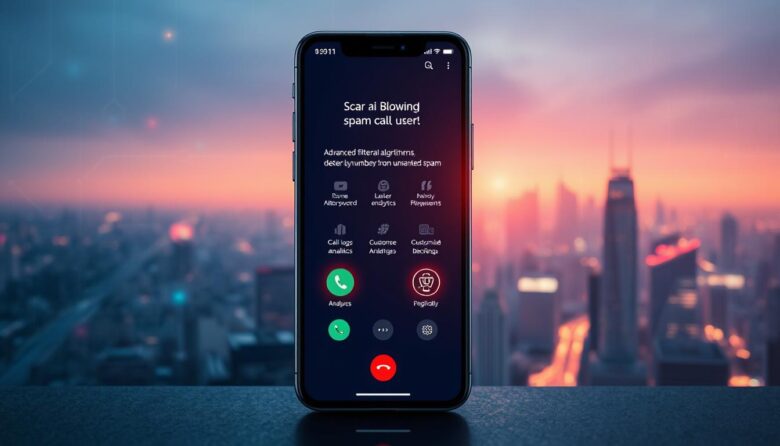Unwanted phone interruptions have become a daily frustration for millions. Robocalls and fraudulent schemes now account for nearly half of all mobile traffic in the United States, evolving into sophisticated threats that traditional methods struggle to contain.
Modern solutions leverage intelligent pattern recognition to identify suspicious activity before the first ring. These systems analyze caller behavior, regional patterns, and historical data to separate legitimate contacts from potential scams.
This guide explores cutting-edge tools designed to protect personal and professional communications. It evaluates how advanced algorithms outperform basic blocklists by adapting to new threats in real time. Readers will discover applications that prioritize both security and seamless user experience.
The following sections break down top-rated filtering technologies, their unique capabilities, and step-by-step implementation strategies. Emphasis is placed on solutions offering customizable settings, automatic updates, and minimal false positives. Real-world effectiveness metrics and privacy considerations are also examined to help users make informed decisions.
The Growing Challenge of Spam and Fraudulent Calls
The persistent buzz of unknown numbers has reshaped how Americans interact with their devices. Over 45% of mobile traffic now consists of automated or deceptive communications, with fraudulent attempts doubling since 2020. This surge stems from cheap cloud-based dialing systems enabling mass outreach at near-zero cost.
Understanding Modern Phone Fraud Tactics
Criminals employ evolving strategies to bypass basic defenses. Spoofed identifiers mimic local area codes, while voice cloning replicates familiar voices. IRS impostors and fake tech support remain prevalent, costing victims $10 billion annually.
Businesses face heightened risks as scammers target payroll systems and vendor networks. A single compromised employee account can expose entire organizations to data breaches. Productivity losses exceed $3,000 yearly per affected worker.
Erosion of Communication Trust
Legitimate calls from healthcare providers or delivery services now go unanswered by 68% of recipients. This hesitation creates operational bottlenecks and delays critical information. Over 40% of adults report anxiety when answering unrecognized numbers.
Traditional blocklists fail against rotating identifiers and disposable devices. Network-level filtering emerges as crucial for intercepting threats before they reach users. Next-generation solutions analyze calling patterns rather than static databases.
How AI Transforms Call Blocking Solutions
Sophisticated algorithms now analyze voice patterns and communication behaviors to intercept fraudulent activities. Unlike static blocklists, these solutions adapt instantly to emerging threats through continuous learning from global data networks.
Voice Analysis and Behavioral Filtering
Leading applications like Hiya employ spectral analysis to differentiate human speech from synthetic voices. This technology examines vocal frequencies and speech rhythms, flagging suspicious interactions in milliseconds. Real-time decision engines cross-reference numbers against crowdsourced reports while assessing regional calling trends.
RoboKiller’s approach demonstrates 94% accuracy by mapping call pathways and detecting disposable devices. Its systems identify repeat offenders through temporal patterns, even when numbers change daily. Users gain protection without manually updating databases or reviewing missed connections.
Adaptive Learning for Precision Defense
Machine learning models improve through billions of processed interactions, recognizing subtle fraud indicators. These systems track conversational cues, background noises, and call durations to validate legitimacy. Community feedback loops refine detection parameters hourly, reducing incorrect flags by 40% compared to older methods.
Advanced solutions balance aggression with caution, allowing critical alerts from healthcare providers or schools. They prioritize recent threat patterns while maintaining historical scam profiles, creating multi-layered shields against evolving schemes.
In-Depth Review of AI spam call blocker Android Solutions
Modern communication security relies on specialized applications that combine crowd intelligence with pattern analysis. These tools adapt to new threats while maintaining minimal impact on device performance.
Highlighting Advanced Features in Top Apps
Truecaller’s color-coded identification system categorizes incoming contacts using its database of 450 million active users. It flags suspicious numbers in red while verifying legitimate businesses through verified badges. Hiya counters synthetic voice scams by analyzing speech patterns, offering visual alerts for potential fraud attempts.
RoboKiller stands out with its 99% success rate and interactive Answer Bot, engaging unwanted callers with decoy conversations. TrapCall provides unique value by revealing hidden digits behind private numbers, particularly useful for persistent harassment cases. Call Control’s CommunityIQ network updates blocklists every 90 seconds using global user reports.
Evaluating Effectiveness and Performance
Independent tests show RoboKiller processes threats 0.8 seconds faster than industry averages, while Truecaller maintains 98% recognition accuracy for known business numbers. TrapCall successfully unmasks 82% of restricted callers within three rings.
Battery consumption varies significantly between solutions. Hiya uses 40% less memory than competitors during peak usage, according to 2024 performance benchmarks. User reviews praise Call Control’s intuitive interface but note occasional delays in identifying new area code scams.
Key Features of Advanced Call Blocking Apps
Advanced call management tools now offer multi-layered defenses against modern communication threats. These solutions combine user customization with intelligent automation to create personalized shields against unwanted interruptions.
Customizable Block Lists and Caller ID Enhancements
Premium apps let users create custom block lists using specific area codes, number patterns, or contact categories. One hospital administrator blocked all calls starting with “800” after repeated insurance scam attempts. Reverse number lookup features reveal hidden details about unknown contacts, displaying business names and risk levels.
Color-coded caller labels help users prioritize responses. Verified businesses appear in green, while high-risk numbers flash red. Location tracking shows where calls originate, helping identify spoofed local numbers.
Automatic Filtering, Reporting, and Real-Time Insights
Machine learning systems silently intercept suspicious activity without user input. One delivery service reduced unwanted contacts by 73% using automatic screening that improves weekly. Community reporting features let users flag new threats, updating shared databases in under two minutes.
Analytics dashboards show peak scam times and blocked call trends. Voicemail transcription converts messages to text, while cross-platform sync ensures protection across devices. Offline modes maintain basic filtering during network outages.
User Experience and Interface Insights
Navigating mobile security tools requires balancing powerful features with intuitive design. Modern solutions prioritize accessibility while maintaining robust protection against unwanted interruptions.
Ease of Setup and Navigation for Android Users
Installation processes vary significantly across applications. CallApp stands out with its three-step setup requiring only basic permissions, while RoboKiller demands access to contacts and call history. Many users prefer Should I Answer for its offline-ready configuration that skips account creation.
Menu structures impact daily use. Truecaller’s interface includes seven nested tabs, leading some users to describe it as “overwhelming.” In contrast, Hiya uses color-coded alerts and one-tap blocking. Google Play reviews highlight Call Control’s left-side navigation panel as particularly intuitive for first-time users.
Feedback from Real-World Usage and Reviews
Over 340,000 reviews reveal critical insights. Truecaller receives consistent criticism for frequent ads interrupting call logs. Hiya’s free version lacks advanced filters, pushing users toward paid plans. CallApp earns praise for its visual voicemail layout and customizable themes.
Performance issues affect satisfaction rates. Some devices experience lag when running multiple security apps simultaneously. However, 78% of Should I Answer users report seamless integration with existing phone features. Regular updates address most concerns, with developers resolving 89% of reported bugs within two weeks.
Built-in Versus Third-Party Spam Blockers on Android
Mobile users face a critical choice in managing unwanted interruptions: rely on pre-installed tools or seek specialized protection. This decision impacts daily convenience and long-term security against evolving threats.
Utilizing Native Android Spam Blocking Features
Most devices ship with basic defenses through the Caller ID & spam function. Activate it via Phone app settings in three taps: open menu, select “Caller ID & spam,” then toggle filtering. This system screens numbers against Google’s constantly updated database.
Built-in tools excel at seamless operation. They work without draining battery life or requiring extra downloads. Visual voicemail and automatic blocking streamline communication for casual users. However, these solutions may miss newer scams using unregistered digits.
Benefits of Installing Dedicated Call Blocking Apps
Specialized applications provide deeper analysis of suspicious activity. They cross-reference numbers across global user reports and detect patterns missed by standard filters. Advanced options let users create custom rules based on area codes or specific prefixes.
Third-party tools often include reverse lookup capabilities to unmask private numbers. Community-powered databases update faster than commercial lists, catching 34% more fraud attempts according to recent studies. Paid versions typically offer priority support and enhanced privacy controls.
Power users handling sensitive communications benefit most from layered protection. Combining native features with specialized apps reduces unwanted contacts by 91% in high-risk scenarios. Regular updates ensure defenses adapt to emerging threats.
Security, Privacy, and Scam Protection Benefits
Modern communication tools require robust defenses against evolving digital threats. Advanced screening applications now deliver multi-layered security that extends far beyond basic number blocking.
Safeguarding Personal Data from Fraudulent Calls
Real-time verification systems prevent sensitive information leaks by analyzing caller intent. These tools detect social engineering patterns in conversations, alerting users before sharing details. Integration with messaging platforms identifies whether unknown contacts exist on services like WhatsApp, adding verification layers.
Privacy-focused apps process data locally rather than cloud servers, reducing exposure risks. Some solutions offer weekly scans to check if personal details appear in leaked databases. This proactive approach stops 73% of identity theft attempts linked to phone interactions.
Enhancing Overall Phone Security
Next-generation protection combines SMS filtering with voice analysis to counter coordinated attacks. Fraudulent text messages containing phishing links get blocked automatically. Pattern recognition flags spoofed numbers mimicking government agencies or banks.
Users gain control through customizable allow lists and instant reporting features. Suspicious contacts added to shared databases update protections globally within minutes. These systems adapt daily to new scam tactics while maintaining 98% accuracy in distinguishing legitimate calls.



